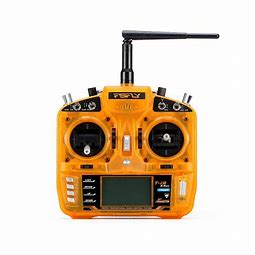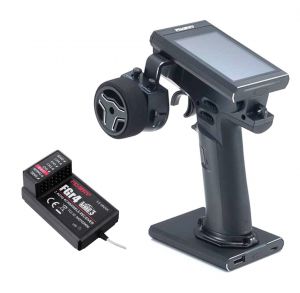Radios
Combat robots usually use R/C hobby radio equipment.[1] This includes:
- A transmitter (Tx), the part that the driver/operator of the bot holds. It sends your instructions to the robot.
- A receiver (Rx) module in the robot to receive your instructions and operate the devices on the bot.
- The receiver module has multiple outputs to connect to those devices. The standard device is a servomotor (servo) for moving things. You can also use an adapters, such as ESCs, to make outputs for turning things (like wheels).
- There are combination Rx and ESC available for building small bots and other RC devices.
- Many Tx only work with a few models of Rx. The Rx must be bound (paired) with the Tx for them to communicate.
- Most Tx sold today can be set up to bind to multiple devices, so you can set up a Tx to operate multiple robots, one at a time.
Follow directions to safely switch on or off the radio equipment without accidentally activating the robot’s devices.
Choosing a Radio
When choosing a radio there are many things to consider but there are three fundamental things that will drive your choice.
- Safety: Runaway robots can be dangerous, so it is critical that your radio system properly handles what is known as a Failsafe situation. When the robot loses signal from the Tx, the Rx must stop all movement and turn off weapons. Not all radios have a failsafe feature, and many must be set or programmed correctly. For instance, aircraft Rx may continue flying or attempt to land if the Tx signal is lost. Many events require that the radio be turned off while people are in the arena to insure that the robot doesn't move.
- Form factor: You may have a preference on the form factor of your radio transmitter. The pistol-grip types have a throttle trigger and steering wheel, and may be easier to learn, though some people feel they lack fine control. Dual-stick radios are generally the most flexible and often have switches which can be programmed for special operations. Transmitters in the shape of game controllers are increasingly common; you may find this type to be more familiar to operate, and the controls may require very short movements. With time and enough practice, the differences between types may become insignificant.
- Functionality: Each robot's requirements are different. A simple wedge robot may only need two channels with a third channel enabling a weapon, but some robot designs need even more channels or other radio programming features.
If you are looking to purchase a radio, take a look at the list of radios that are known to be suitable for robot combat.
Common problems
Since the radio Rx passes signals to the robot's Electronic Speed Controllers to drive the robot's functions, it can sometimes be difficult to determine if the problem is with the radio or the ESC. To make troubleshooting easier, solutions to common problems that affect the whole system are described here.
Team Run Amok's Ask Aaron site is a good resource for additional information and troubleshooting.
This section needs additional details.
- Failsafe: What does your receiver do when it loses its signal? Some inexpensive radio systems will act unpredictably with signal loss, while other systems will continue on with their last good signal until they can reconnect. This 'continue' behavior can be useful for some RC systems but can be dangerous for robot combat. Check out the radio list for systems that can be set up to failsafe appropriately. If your radio system can't failsafe then most events will not allow it, especially for bots that have active weapons. It's important to remember that often the radio defaults will not work correctly and you will need to adjust them.
- Signal Loss:
- Not Binding / Connecting:
- Compatibility:
- Too Responsive:
- Controls Reversed:
- Only one motor responds:
- Robot hums or whines:
- Robot won't stop moving:
Radio Type (stick, pistol, game controller, joystick)
Programming a radio
Radio Mixing

